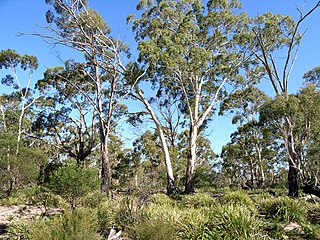
Eucalyptus viminalis, commonly known as the manna gum, white gum or ribbon gum, is a species of small to very tall tree that is endemic to south-eastern Australia. It has smooth bark, sometimes with rough bark near the base, lance-shaped to curved adult leaves, flower buds in groups of three or seven, white flowers and cup-shaped or hemispherical fruit.
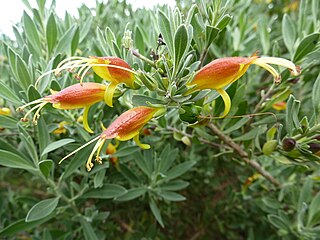
Eremophila glabra, commonly known as tar bush, is a plant in the figwort family, Scrophulariaceae and is endemic to Australia. It is sometimes a low, ground-hugging and sometimes an erect shrub. The leaves are variable in size and shape and there is a range of flower colours. In spite of its scientific name, not all forms of the plant are glabrous but most have many small, raised glands on the stems, flowers and leaves.

Pimelea spicata, commonly known as the spiked rice flower, is a flowering plant in the family Thymelaeaceae and is endemic to New South Wales. It is a slender plant with white flowers and elliptic leaves.

Cryptostylis erecta, commonly known as the bonnet orchid or tartan tongue orchid , is an orchid endemic to south eastern Australia. A small and common plant, it has dark green lance-shaped to egg-shaped leaves and up to twelve greenish flowers with a large, bonnet-like or hood-like, lilac-coloured labellum with a network of purple veins.

Persoonia myrtilloides, commonly known as myrtle geebung, is a plant in the family Proteaceae and is endemic to New South Wales. It is an erect to spreading shrub with elliptic to egg-shaped leaves and yellow flowers in groups of up to forty on a rachis up to 170 mm (6.7 in) long.

Persoonia mollis, commonly known as soft geebung, is a plant in the family Proteaceae and is endemic to New South Wales. It is an erect to prostrate shrub with linear to oblong or spatula-shaped leaves, yellow flowers in groups of up to thirty on a rachis up to 150 mm (5.9 in) long and relatively small fruit.

Petrophile canescens, commonly known as conesticks, is a species of flowering plant in the family Proteaceae and is endemic to eastern Australia. It is an erect shrub with pinnately-divided leaves and oval heads of hairy, white to pale cream-coloured flowers.

Prostanthera denticulata, commonly known as rough mint-bush, is a species of flowering plant in the family Lamiaceae and is endemic to coastal New South Wales. It is a straggling to almost prostrate, aromatic shrub with narrow egg-shaped leaves and purple to mauve flowers arranged in leaf axils or on the ends of branchlets.
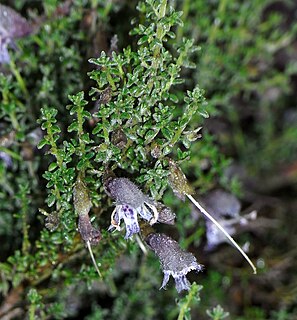
Prostanthera serpyllifolia, commonly known as small-leaved mint-bush, is a species of flowering plant in the family Lamiaceae and is endemic to southern Australia. It is a small shrub with small egg-shaped leaves and bright pink to red or metallic bluish-green flowers.

Persoonia curvifolia is a plant in the family Proteaceae and is endemic to central New South Wales. It is an erect to spreading shrub with linear leaves and somewhat hairy yellow flowers.

Persoonia tenuifolia, commonly known as fine-leaf geebung is a plant in the family Proteaceae and is endemic to eastern Australia. It is an erect to low-lying shrub with hairy young branchlets, linear leaves, and yellow flowers in groups of up to eight on a rachis 2–30 mm (0.079–1.181 in) long that continues to grow after flowering.

Persoonia microphylla is a plant in the family Proteaceae and is endemic to New South Wales. It is an erect to prostrate shrub with elliptic to egg-shaped leaves and yellow flowers in groups of up to fourteen on a rachis up to 30 mm (1.2 in) long.

Pterostylis cucullata, commonly known as the leafy greenhood, is a plant in the orchid family Orchidaceae and is endemic to south-eastern Australia. It has a rosette of fleshy leaves at its base and a single white, green and reddish-brown flower.

Petrophile ericifolia is a species of flowering plant in the family Proteaceae and is endemic to southwestern Western Australia. It is a shrub with cylindrical leaves, and oval to spherical heads of hairy, yellow flowers.
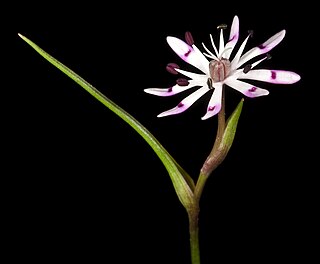
Wurmbea tenella, common name - eight nancy, is a perennial herb in the Colchicaceae family that is native to Western Australia.
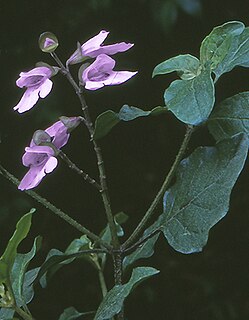
Prostanthera prunelloides is a species of flowering plant in the family Lamiaceae and is endemic to eastern New South Wales. It is a shrub with four-ridged branches, egg-shaped to round leaves and white or pale mauve flowers.

Goodenia scapigera, commonly known as white goodenia, is a species of flowering plant in the family Goodeniaceae and is endemic to the south-west of Western Australia. It is an erect, perennial herb or shrub with linear to narrow egg-shaped leaves clustered near the ends of the stems, and thyrses of white flowers with purplish spots.
Wurmbea latifolia, also known as Broadleaf Early Nancy, is a species of plant in the Colchicaceae family that is endemic to Australia.

Wurmbea biglandulosa is a species of plant in the Colchicaceae family that is endemic to Australia.
Wurmbea citrina is a species of plant in the Colchicaceae family that is endemic to Australia.


















